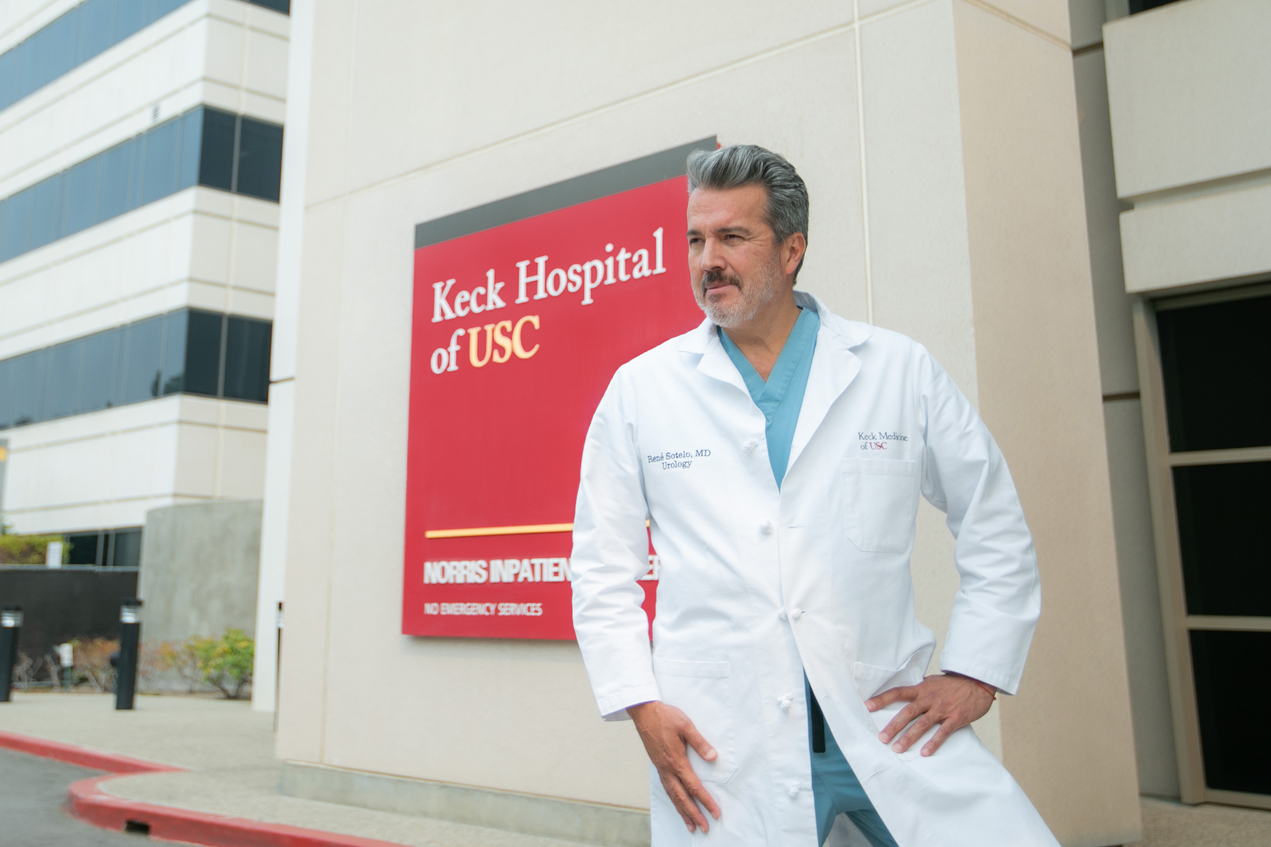When Randy Beatty, a 68-year-old professor of accounting in the USC Marshall School of Business, decided to go on a ski vacation, he never imagined a pre-trip checkup would result in surgery instead of schussing the powder.
“My primary care physician ordered a routine blood workup and when the results came back, I had extraordinarily high PSA numbers,” Beatty said. “That rang some serious alarm bells and I went to Keck Hospital for a prostate biopsy.”
The prostate is a Ping-Pong ball-sized gland situated deep inside the male groin and serves an integral function in the reproductive process. Prostate-specific antigen, or PSA, is a protein produced by normal, as well as malignant, cells of the prostate gland. High levels can be an indication of cancer.
The biopsy was negative for cancer, but examination showed Beatty’s prostate was enlarged, a condition known as prostatitis, and needed immediate attention. He chose to see René Javier Sotelo, MD, a urologist with USC Urology, professor of clinical urology at the Keck School of Medicine of USC and medical director of international medicine at Keck Medicine of USC.
“Prostatitis is typically a result of some combination of aging, your genetics and hormone activity. For example, testosterone can make it grow,” Sotelo said. “Cancer is also a common issue.”
Beatty had several choices of treatment. One was to undergo a procedure that would provide relief, but likely require another surgery in 10 years. “The idea of surgery at 78 years of age wasn’t appealing,” Beatty said. “The other option was complete removal of the prostate.”
“I had twinges of anxiety at the beginning,” Beatty continued. “Dr. Sotelo is warm, caring and communicates with empathy. He was everything you’d expect from a Keck physician; what a leader looks, acts and sounds like.”
As the prostate enlarges, it can put pressure on the bladder, making urine flow weaker and cause multiple trips to the bathroom, especially at night. Over time, enlargement can make urination almost impossible, which requires immediate medical attention.
“Although non-cancerous, the prostate was extremely enlarged, one of the five largest I have seen,” Sotelo said. “With the prostate, depending on the situation, we often begin treatment with medicine, then move to other options such as surgery. When the patient decided upon removal, the ideal option was the da Vinci minimally invasive robotic system we have at Keck.”
Sotelo is one of the world’s most experienced operators of the da Vinci robotic system. “It’s very important to have an experienced da Vinci surgeon,” Sotelo said. “It’s a robotic system, but the robot doesn’t do it by itself. The surgeon’s fingers are linked to the device, which perform the surgeon’s actions. What makes the da Vinci system so effective is the camera in the robot allows the surgeon to see the target much better via 3D, high definition, 10X magnification on screen. And the da Vinci eliminates tremors; the instrument moves with extremely smooth precision.”
Unlike invasive open surgery, da Vinci robotic minimally invasive surgery has typically fast recovery times. “I spent the night, and in the morning Dr. Sotelo arrived to check on me,” Beatty said. “I asked him when I could expect to go home, and when he said ‘tonight,’ I was over the moon. Today, you’d never know I had surgery from looking at my abdomen. The incision marks are almost invisible.”
Sotelo always enjoys connecting and communicating empathetically with patients. “You can’t fathom the discomfort that comes from being unable to pee, until you can’t do it. I get great joy at seeing the immediate relief a patient gets in the hours following a da Vinci procedure,” Sotelo said.
“Dr. Sotelo reached out to my wife, Ellen, while I was in post-op recovery to update her on my condition. She was grateful and felt very comfortable speaking with him,” Beatty said. “He’s not just a great talent, but also a great humanist. The Keck experience was one of having access to a world-class physician and surgical techniques that changed my life for the better.”
Around 30% of the da Vinci prostate-specific procedures Sotelo performs are for benign (non-cancerous) prostatitis, and 70% are for cancer. Prostate cancer affects 1 in 8 men. “Today, 90% of prostate cancer surgeries are done robotically,” Sotelo said. “Men should understand, upon diagnosis of symptoms and size, that they have many excellent options.”
— David Zartman


